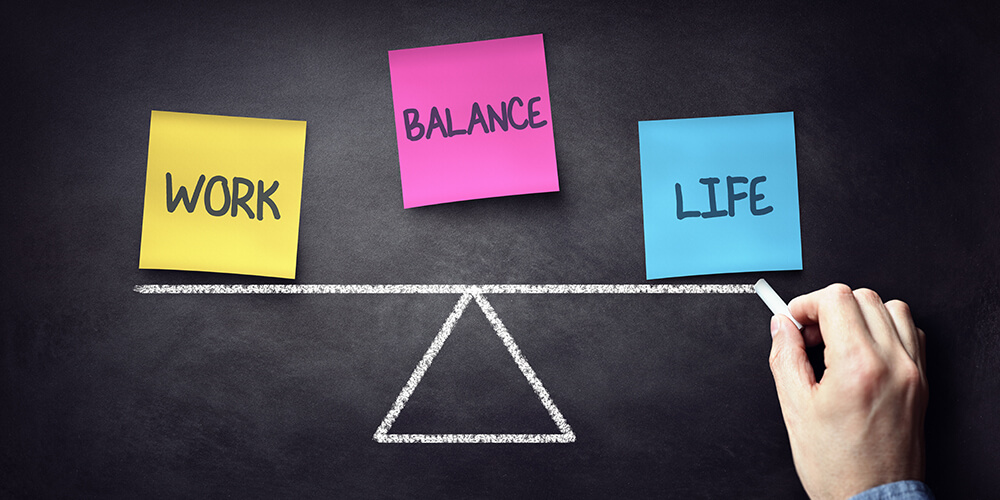Creating a balance between work and life can be challenging where both demand your attention and energy. Being able to balance a career and life, makes a person healthier, mentally and physically, with an enhanced lifestyle.
Work-life balance is a key part of self-care when juggling the responsibilities of your workday, home life, and relationships with your family members and other loved ones.
Work-Life Balance does not mean an equal balance rather it is the ability to experience a sense of control and to stay productive at work while maintaining a happy, healthy home life with sufficient leisure.
Also, read Health And Physical Benefits Of Carrots And Carrot Juice.
Work-life balance is proper prioritizing between “work” (career and ambition) on one hand and “life” (Health, pleasure, leisure, family, and spiritual development) on the other.
Often organization culture and workplace practices control an individual’s work life and put the organization’s desires before the individual’s needs.
SIX ESSENTIALS OF WORK-LIFE BALANCE
- Self-Management
- Time Management
- Stress Management
- Change Management
- Technology Management
- Leisure Management
IM-BALANCE OF WORK
An in-balance is fundamentally a lack of clearly defined and consistently enforced boundaries between work life and personal life.
Failure to achieve a healthy work-life balance leads to people experiencing emotional stress, anxiety, and depression.
Anybody who can balance their professional and personal life is happier, healthier, and more productive.
AGENT OF WORK-LIFE IMBALANCE
- Social Support
- Organizational Factor
- Stress Factor
- Work Issue Factor
- Family Issues Factor
- Individual Factor
CAUSES OF WORK-LIFE BALANCE
- Increased expenses without a salary increase.
- Increased responsibilities at work.
- Increased responsibility at home.
- Working longer hours.
Other causes of work-life imbalance are:
- Less family participation
- Limited friendships
- Increased burdens and workload
- Distance in personal relations
- Decreased level of refreshment by oneself
EFFECTS OF WORK-LIFE IMBALANCE
Health Risks: Obesity: Lack of exercise and bad eating habits can increase obesity, which is connected to heart disease and numerous other health risks.

Exhaustion: Not sleeping and overworking.
Emotional problems: This will affect relationships and personal identity.
Absenteeism: Bad health results in employee absenteeism and a huge cost to both employer and employee.
Also read Five Things You Need To Know About Hotel And Spa Management Software Today
Burnout: It is the physical and psychological response to long-term stress i.e. lack of interest, lack of emotion, lack of motivation, and possible depression.
Stress: Stress can lead to Cardiovascular disease, Sexual health problems, Weakened immune system, Migraines and headaches, Stiff muscles, Backaches, depression, Weight gain, Substance addiction, nervousness, trouble concentrating, Irritability, mental and physical fatigue.
BENEFITS OF A HEALTHY WORK-LIFE BALANCE
- A motivated employee
- Better levels of efficiency
- Increase in productivity
- Decrease in absence due to sick and stress
- Improves customer support
- More competition to work in the concern
- Higher retention level
- Success in achieving goals
Thus, maintaining a good work-life balance benefits both the employer and the employee
HOW CAN AN EMPLOYEE/EMPLOYER ENSURE WORK-LIFE BALANCE
Some important steps to ensure work-life balance for an employee.
- Take some break
- Set priorities
- Do exercise every day
- Spend time with family and friends
- Take holiday trips
- Maintaining healthy diet habits
- Getting enough sleep
- Pursuing hobbies
- Leaving work pressure at work
- Schedule one activity you look forward to a day
- Know when to say no
Some important steps to ensure work-life balance for an employers

- On-the-Job Training
- Surveys of employees’ work/life issues.
- Set priorities for all work.
- Train line managers to recognize signs of overwork.
- Seminars on work/life balance.
- Make Work More Flexible
- Flextime or Job sharing
- Sponsoring employees’ family-oriented activities.
- Allow for Time Off from Work
- A formal leave policy.
- Paid childbirth or adoption leave.
Also read: 15 Good Reasons You Should Drink Enough Water Daily
BENEFITS TO ORGANIZATION
- The measured increase in productivity, accountability, and commitment
- Better teamwork and communication.
- Improved morale.
- Less negative organizational stress.
BENEFITS TO EMPLOYEES
- More value and balance in daily life.
- A better understanding of work-life balance
- Increased productivity.
- Improved on-the-job and off-the-job relationships.
- Reduced stress.
CONCLUSION
Also read: The Big Lesson Bill Gates Is Trying To Teach Us With His Summer Reading List
Work-life balance is an ideal and making deliberate choices and setting priorities will make an individual feel relaxed and organized. It will lead to increased productivity and the accomplishment of tasks quickly, and improved relationships with families and friends.
BY OLOYEDE ADEOLA














Leave a comment